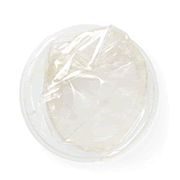Yes, try using an internal condom. It’s a barrier method that’s inserted into the vagina (or your butt with the internal ring removed) that will help protect against sexually transmitted infections (STIs). Just keep in mind, you can’t use an internal condom and a condom at the same time.
Internal condom (FC2)

I'm tired of using condoms, is there another birth control method that will also protect me from STIs?
How do you remove a internal condom?
Removing an internal condom is pretty straightforward once you get the hang of it. To prevent pregnancy, you’ll twist the parts on the outside of your body closed like a baggie, so semen doesn’t spill out when you remove it. You might want to practice a few times before sex, so you are a pro when you need it.
Want to learn more?
Want to learn more?
How do you insert a internal condom?
Check out our section on how to insert an internal condom.
Want to learn more?
How common are STIs?
There are a few things you can do to protect yourself from STIs. First, get vaccinated for HPV and Hepatitis B, use condoms or internal condoms when you have sex, get tested regularly, use PrEP (and PEP) and talk openly about sexual health with your partner(s).
Super common. 1 in 2 people will get a sexually transmitted infection (STI) by the time they reach the age of 25.
There are a few things you can do to protect yourself from STIs. First, get vaccinated for HPV and Hepatitis B, use condoms or internal condoms when you have sex, get tested regularly, use PrEP (and PEP) and talk openly about sexual health with your partner(s).
Want to learn more?
When I stand up with my internal condom in, it sticks out a little. How can I stop it from doing that?
Fun fact: You can insert the internal condom hours before having sex. Not-so-fun fact: if you stand up with it in, the internal condom will hang slightly out of the vagina. The part that sticks out helps the internal condom stay in place and helps protect you from skin-to-skin transmission of STIs. If you want to insert it early, you might want to try wearing a snug pair of underwear when out and about to hold the external part of the condom closer to your body if it bothers you.
Want to learn more?
What's the deal with double bagging?
When it comes to condoms, two is definitely not better than one. Using two condoms or a condom and an internal condom at the same time can create more friction, which increases the chance of the condom(s) breaking. If you want extra pregnancy prevention, double up with a condom and another method of birth control.
Want to learn more?
Is anal sex safer than vaginal sex?
To protect yourself while having anal sex, make sure you’re using enough lube and use condoms or internal condoms with the inner ring removed.
It depends on what you mean by safer. You can’t get pregnant from having anal sex, but anal sex without a condom or internal condom has a higher risk for sexually transmitted infections (STIs). That’s because the skin of your anal cavity is made up of delicate tissue, which means small tears and cuts are common—especially if you’re not using enough lube during anal sex—which can lead to additional entry points for infections like STIs.
To protect yourself while having anal sex, make sure you’re using enough lube and use condoms or internal condoms with the inner ring removed.
Want to learn more?
Is birth control available over the counter?
In the U.S. there are a bunch of types of birth control available over the counter without a prescription or talking to a pharmacist. Condoms, internal condoms, spermicide, the sponge, as well as emergency contraception pills and one type of birth control pill.
Want to learn more?
What types of lube are safe to use with latex condoms?
Both water-based and silicone-based lubricants are totally safe to use with latex condoms. Steer clear of oil-based lubricants (including massage oil, hand lotion, Vaseline, and all types of cooking oil, including coconut oil) that can cause condoms to break.
Want to learn more?
Can I tell if someone else has an STI?
Probably not. The most common symptom of all STIs is no symptom at all. STIs are often asymptomatic or display such mild symptoms they go unnoticed or are mistaken for something else. For that reason, most people with an STI don’t know they have one. Even when STIs have no symptoms or only mild symptoms, it’s still possible to pass them to others. Untreated STIs can cause long-term health problems internally long before we’re aware of their effects, so it’s important to get tested regularly.
Want to learn more?

Heat up your weekends with our best sex tips and so much more.